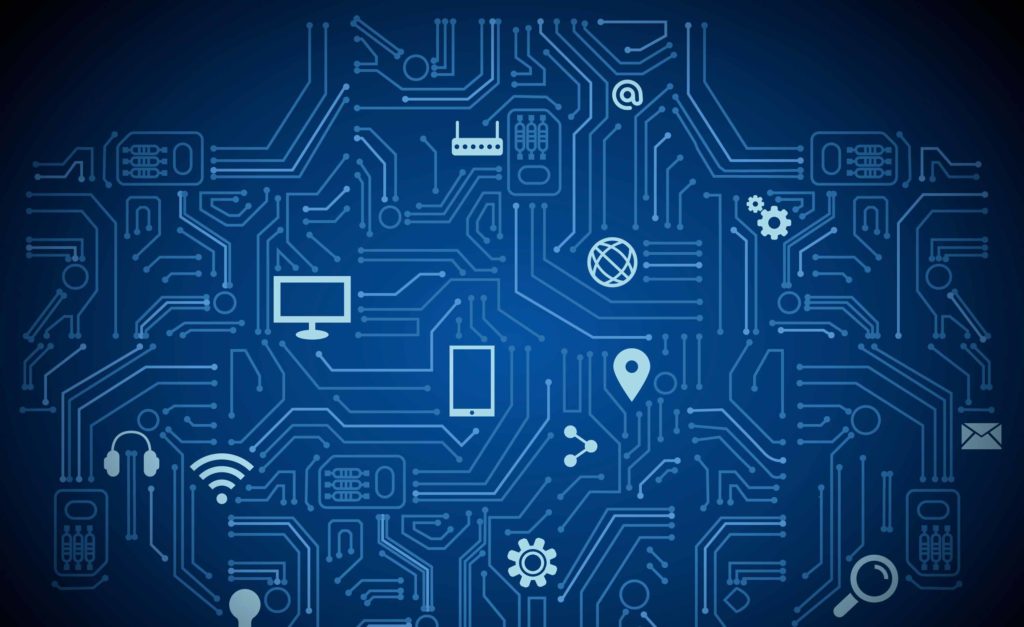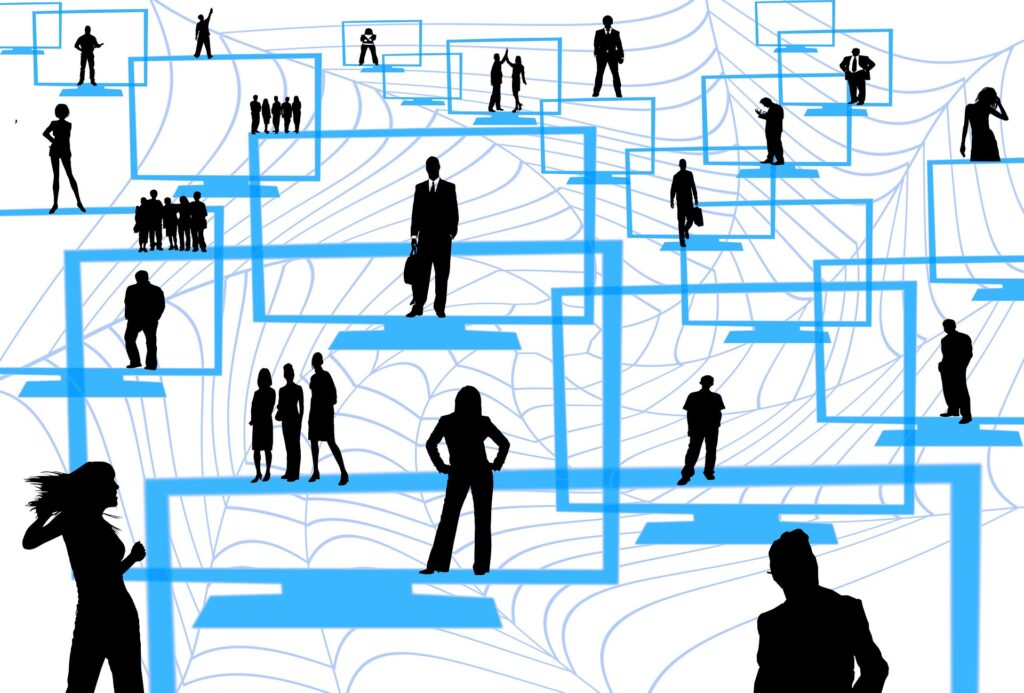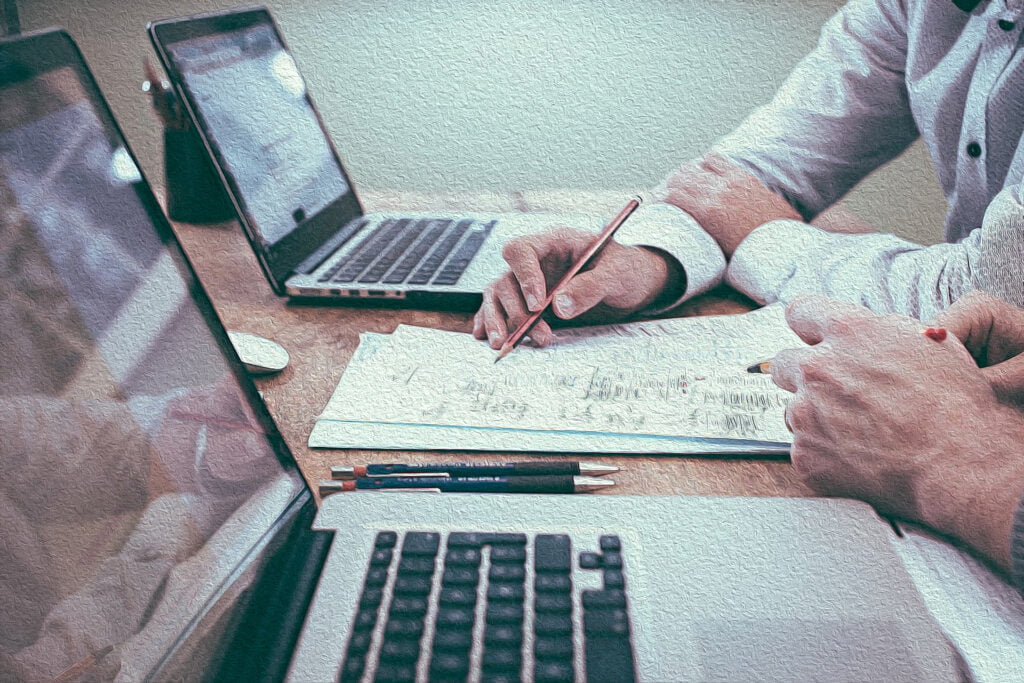What is the meaning of IT infrastructure? Basically, IT Infrastructure refers to a set of hardware, software and services that required to operate an organization. In this chapter, we discuss this IT Infrastructure, its evolution, and the components of IT Infrastructure.
Key highlights
- The meaning of IT infrastructure
- The evolution of IT infrastructure
- Components of IT infrastructure
What is IT Infrastructure?
The information technology infrastructure or IT infrastructure refers to consists of physical devices (Hardware) and software that required to operate the entire organization or entire business units.
And also this can be defined as a set of firm-wide services. These services include computer services, data management services, application software services, physical facilities management services, and IT management. Therefore, an IT infrastructure provides the foundation to interact with stakeholders for the organization.
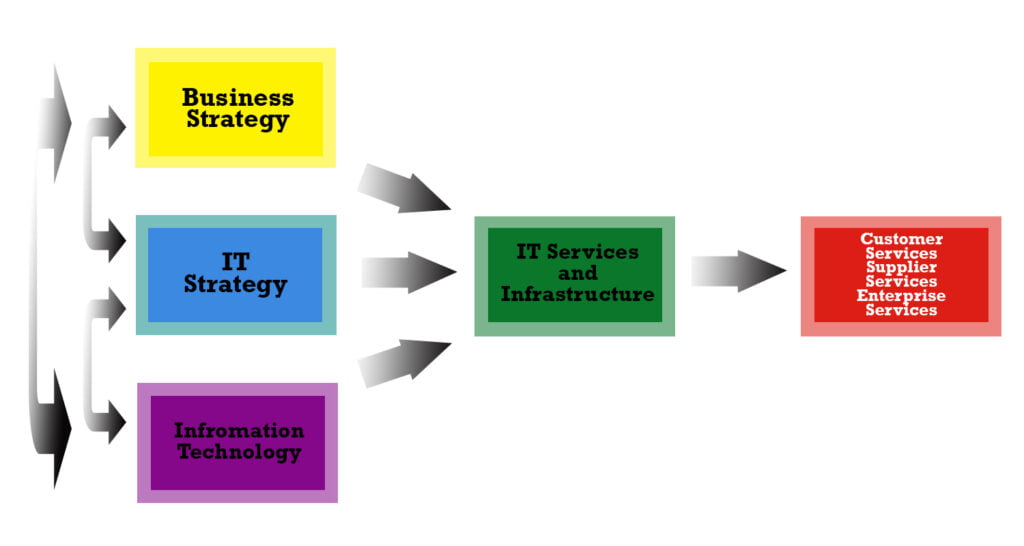
The Evolution of IT infrastructure
The IT infrastructure has more than 50 years of evolution in computing platforms. This evolution has five stages and each stage represents a various configuration of infrastructure elements and computing power. The 5 eras of evolution in IT infrastructure are as follows.
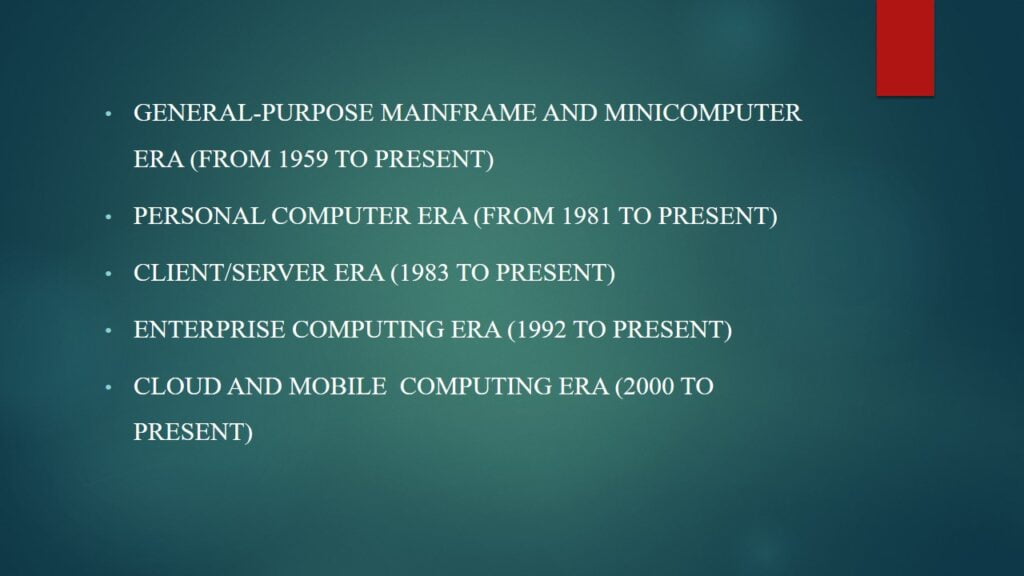
General-purpose mainframe and minicomputer era
Basically, this mainframe era was a highly centralized computing platform. In this era, the computers were controlled by system operators and professional programmers with the support of a single vendor or the manufacturer of the hardware/software.
In 1959, IBM 1401 and 7090 transistorized machines were invented. This is the remarkable beginning of mainframe computers. After that with the introduction of the IBM 360 series in 1965, IBM has dominated in mainframe computing. This IBM 360 series was able to provide multitasking facility, time-sharing, and virtual memory. And also it was the first commercial mainframe computer with a powerful operating system.
Eventually, this mainframe pattern began to change by reason of introducing minicomputers. These minicomputers were produced by DEC (Digital Equipment Corporation) in 1965. And these were more powerful than IBM mainframes. Not only about the power but also the price was lower than the IBM mainframes. Decentralized computing, ability to customize for specific needs of business units were the features of these minicomputers.
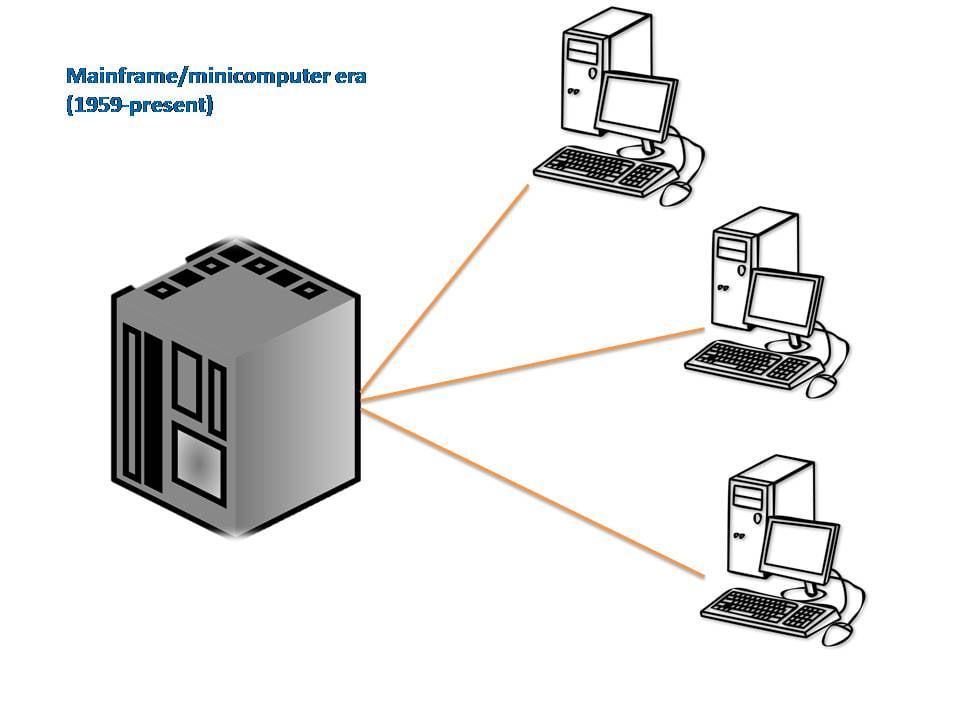
Personal computer era:
The MITS Altair 8800, the Xerox Alto, Apple I and II can be recognized as the first truly personal computers in the 1970s. But there was limited distribution of these computers to computer users. Therefore the IBM PC in 1981 was considered as the beginning of the personal computer era by reason of wide usage in American businesses. In the beginning, personal computers used the DOS operating system and a text-based command language, and later the Microsoft Windows operating system. Then, a computer with a Windows operating system and Intel microprocessor became the standard personal computer. As a percentage, 90% of computers run on a Windows operating system and 10% run a Macintosh operation system
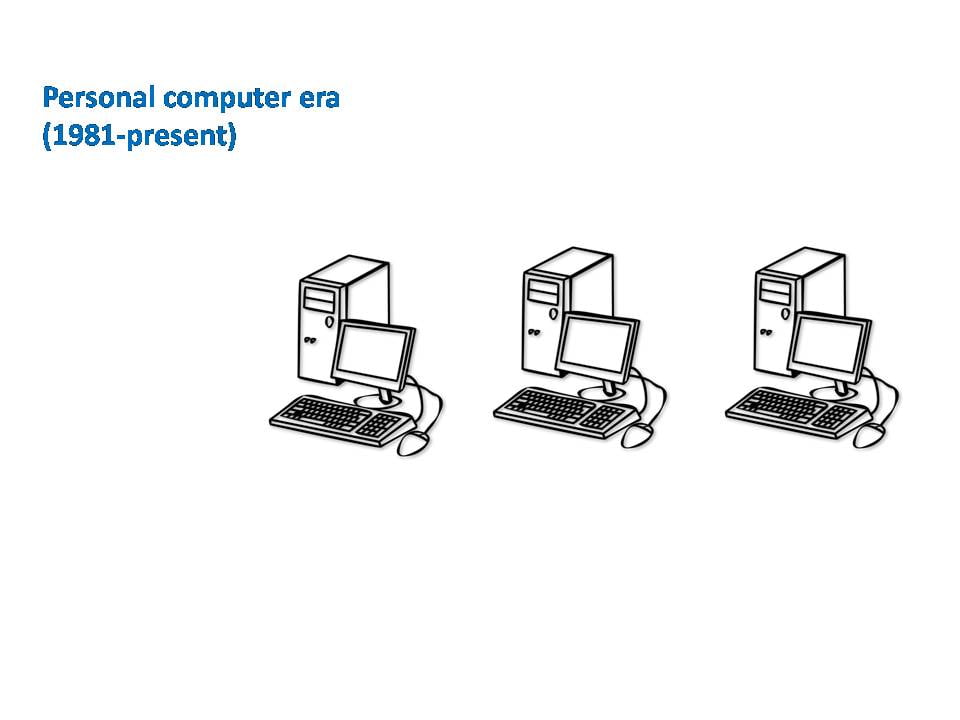
Client/server era
In client/server computing, desktop or laptop computers client computers and computers that provide different services or capabilities called server computers. Also, a server computer can be defined as a software application or a physical computer that runs network software. Today, server computers are more powerful rather than personal computers. Usually, the server computers are driven by inexpensive chips, multiple processors in a single computer casing or in server racks.
Enterprise computing era
Later 1995s, the internet has developed into the next level as a trusted communication environment. Because of this development, the organizations began to use Internet Protocol/Transmission Control Protocol (IP/TCP) networking standards heavily to combine their dissimilar networks together. So the final result of this development is, the IT infrastructure links small networks and a variety of computer hardware into an enterprise-wide network. Therefore the information will able to flow freely through the organization and with other organizations also. It can link various types of computer hardware, including mainframes, personal computers, servers, mobile devices and also includes public infrastructure.
Cloud and mobile computing era
The fast development of the internet has pushed the client/server model into the next step, which is called the cloud computing model. This cloud computing model can be defined as a computing model that provides access to a shared pool of computers, applications, services, and storage over a network, mostly using the internet. Thousands of computers are connected with cloud data centers and, users can access this by using any connected device such as desktop computers, laptop computers, tabs, and smartphones.
Components of IT infrastructure
When considering the components of IT infrastructure, there are 7 major components, including computer hardware platforms, operating systems platforms, enterprise software applications, networking telecommunication, consultants & system integrators, data management & storage, and internet platforms.
These components and their vendors are as follows
Computer Hardware platforms
The firms worldwide spend more money on computer hardware including severing devices as well as client devices. When considering about server market, they mostly use Intel or AMD processors for their computers. And also use Sun Spare microprocessors and IBM chips that specially designed for server computers.
In the computer hardware market, the leading producers are IBM, HP, DELL, and Sun Microsystems which is acquired by Oracle. And also Intel and AMD are the leading companies in producing processors.
Operating System platforms
In the server operating system market, 35 percentages of firms use windows operating systems and 65 percentages of corporate servers use Linux operating systems or UNIX operating systems. When considering about client level, 90 percentages of users use Microsoft Windows operating system (Windows 8, 8.1, Windows 10) to run their personal computers. And also, mobile devices run with an Android operating system powered by Google. Although most of the mobile devices run with Android OS, the Apple devices (iPhone, iPad, MacBooks) run with IOS. And, there is a big competition between these operating systems.
Enterprise software applications
Basically, an enterprise software application is software with a large volume of data. This software collects data from every business function. This enterprise software is so beneficial to the organization. The information can be shared through all management levels and functional levels.
The leading producers of enterprise application software are SAP and Oracle.
Data management and storage
Data management software is useful for organizing and managing data in the entity. Therefore the managers and other users can access and use information efficiently. The leading database management software providers are Oracle, Microsoft, IBM, and Sybase.
In the physical data storage market, the EMC Corporation is the most leading provider for large-scale systems. And leading PC hard disk providers are Seagate and Western Digital. The amount of new digital information is developing day by day. Therefore the demand for digital data storage devices has been increasing at more than 15% annually over the last 5 years.
Networking/Telecommunication Platforms
Cisco, Alcatel-Lucent, Juniper Networks, and Nortel are the leading providers in the Networking Hardware market. The technology is developing rapidly; therefore firms worldwide are spending billions of money on telecommunication equipment to manage telecommunication or networking. The firms require telecommunication platforms, these telecommunication platforms are provided by telephone services companies that offer connectivity (voice and data), wide area networking (WAN), internet access, and wireless services.
This telecommunication service market is expanding by reason of new providers of High-speed internet, and internet telephone services.
Internet platforms
Internet platforms influence an entity’s general networking infrastructure, hardware platforms, and software platforms. These platforms include hardware, software, and management services to support the organization’s website, routers, networking equipment, and web hosting services.
The major web software developing tools and suits are produced by Microsoft, Oracle-sun, and independent software developers.
Consulting and system integration services
When an organization decides to implement a new infrastructure, it requires a change in business processes and procedures, training & development, and software integration. But today, even a large entity does not have a staff, required skills, a budget, or other significant experience to maintain the entire IT infrastructure. In this case, some leading firms provide this expertise. (IBM global services, HP, Infosys, Wipro technologies)
System integration refers to ensuring the new IT infrastructure works with the firm’s previous, so-called legacy systems. And also it ensures new elements of the infrastructure work with one another.


